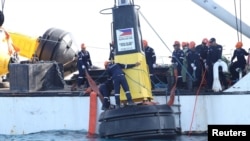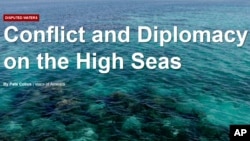In a tit-for-tat move in the evolving dispute over South China Sea sovereignty, China has set up three “navigation beacons” in the maritime region to offset five navigation buoys placed by the Philippines.
The move comes as Philippines President Ferdinand Marcos Jr. has pursued warmer ties with the United States, including giving the U.S. access to more military bases in the face of China's increasingly aggressive actions in the area.
China’s Ministry of Transport announced on May 24: "To ensure the safety of ships' navigation and operations, the South China Sea Navigation Security Center of the Ministry of Transport deployed three navigation beacons in the waters near Irving Reef, Whitsun Reef and Gaven Reef in the Nansha Islands [the Spratly Islands]."
The announcement came after the Philippine Coast Guard said it had set up five nationally flagged buoys from May 10 to 12 in areas within its 322-kilometer exclusive economic zone.
All three reefs are in waters that Manila says are within its EEZ, where under international law it enjoys sovereign rights to economic exploitation and exploration. Hundreds of Chinese Maritime Militia ships were berthed at Whitsun Reef in 2021.
Beijing has claimed every feature in the South China Sea, while Brunei, Malaysia, the Philippines, Taiwan and Vietnam also claim certain islands in the sea as part of their territory.
VOA special report:
According to a Chinese media report, Chinese fishermen collected all the buoys deployed by the Philippines under the protection of Chinese coast guard boats.
VOA Mandarin emailed the Philippine Coast Guard and the Chinese Ministry of Transport for comment regarding the recent developments in the Sino-Philippine maritime standoff, but neither responded by the time of publication.
“It's a tit-for-tat scenario — depends on what the function of these buoys are for,” said Alexander Neill, who is an adjunct fellow at the think tank Pacific Forum. “There are various roles for buoys, which can include simply marking out sea space or warning vessels of obstacles or guiding vessels through particular steep channels.
“But there's a technological edge to some of these buoys,” the Singapore-based security analyst told VOA. “Buoys can be used for surveillance.”
Xu Liping, director of the Center for Southeast Asian Studies at the Chinese Academy of Social Sciences, told China’s official Global Times on May 24 that Beijing’s buoy placements show China’s “determination to stabilize the situation in the South China Sea.”
Ding Duo, deputy director of the Institute of Ocean Law and Policy of the National Institute for South China Sea Studies, said in the same Global Times report that “by placing the buoys, China is also fulfilling its international obligation as the largest country in the region, providing maritime public goods to the international community to safeguard navigation safety.”
Neill, however, said the two countries are competing to place buoys in the South China Sea mainly to demonstrate territorial sovereignty. He questioned China’s assertion that the light buoys are for navigation because for decades, large cargo ships or oil tankers have sailed the waters unhindered.
He called the buoy placement part of an effort to distract international attention from China’s military interest in the area. Beijing has been building up reefs in the South China Sea since 2013 and militarized at least three of them by installing anti-ship and anti-aircraft missile systems, laser and jamming equipment and fighter jets.
“Recently, we've seen concentrations of Chinese fishing vessels, which are dual-roled as the maritime militia, so they are networked into the communications, command and control networks of the People's Liberation Army, the military presence in the South China Sea,” Neill told VOA. “And those kinds of beacons could be used to facilitate their own navigation.”
Yao Cheng, a former lieutenant colonel of the Chinese Naval Command who now lives in Los Angeles, also said that buoys, while useful for ships entering and leaving ports, have limited effectiveness at sea given the accuracy of GPS navigation and positioning systems on modern ships.
Yao said he thinks China set up the buoys to set an example for the region.
"The Chinese Communist Party can't fight Taiwan now, and it has no way to confront Japan [and other countries] militarily, but it must fight the Philippines,” he said. “Because if it doesn't, the neighboring countries in the South China Sea will (follow the Philippines’ example) and rely on the U.S."
Neill said that China has used "gray zone tactics" in the area between the Spratly and Paracel islands to create conflicts that deter opponents. Gray zone tactics are “below the level of war,” according to a CSIS report, and include “election meddling, economic coercion, and the ambiguous use of unconventional force” — such as civilian fishing fleets.
He said because China's military strength far exceeds that of the Philippines, Beijing can use gray zone tactics to coerce Manila. But he also believes that China, the Philippines and the U.S. will avoid escalation.
Walden Bello, a former Philippine congressman in Manila, said the two countries have used buoys to assert territorial sovereignty for over a decade. He believes that as long as the situation does not escalate, it is a "harmless game" between the two countries.
“Taking out buoys, putting them in, it could just be some sort of a harmless chess game,” Bello told VOA Mandarin in a phone interview. “If that territorial conflict can be kept to that level, I wouldn't say I would be happy, but I'd be relieved,” he said.
Adrianna Zhang contributed to this report.







